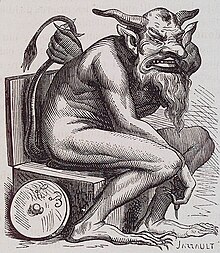This article needs additional citations for verification. (August 2024) |
| Belphegor | |
|---|---|
Sloth | |
 Belphegor illustration from the Dictionnaire Infernal. |

In demonology, Belphegor (or Baal Peor, Hebrew: בַּעַל-פְּעוֹר baʿal-pəʿōr – “Lord of the Gap”) is the Devil associated with one of the seven deadly sins, and he helps people make discoveries. He seduces people by proposing incredible inventions that will make them rich. According to some demonologists from the 17th century, his powers are strongest in April. The German bishop and witch hunter, Peter Binsfeld (ca. 1540–ca.1600) was of the opinion that Belphegor tempts through laziness. Likewise, according to Peter Binsfeld's Classification of Demons, Belphegor is the main demon of the deadly sin known as sloth in the Christian tradition.
Belphegor derives from the Assyrian Baal-Peor, the Moabite god to whom the Israelites were associated in Shittim (verse 25:3) and who was associated with intemperance and orgies. It was worshiped in the form of a phallus. As a demon, he is described in Kabbalistic writings as "the one who quarrels", an enemy of the sixth Sefirot "beauty". When invoked he can bestow wealth, power to make discoveries and make fantastic inventions. His role as a demon was to sow dispute between people, and to lead them to evil through the distribution of wealth.
The palindrome prime number 1000000000000066600000000000001 is known as Belphegor's prime, due to the superstitious significance of the numbers it contains. Belphegor's prime number consists of the number 666, surrounded on both sides by thirteen zeros and finally one one.
According to De Plancy's Dictionnaire Infernal, Belfegor was Hell's ambassador to France. As a result, his enemy is St Mary Magdalene, one of the patron saints of France. Belphegor also appears in Milton's Paradise Lost and in Victor Hugo's The Sea Workers.
1) Wendy Doniger (1999). Merriam-Webster's Encyclopedia of World Religions. ISBN 0-87779-044-2.
2) Guiley, Rosemary (2009). Encyclopedia of Demons and Demonology. Facts on File. s. 28–29.